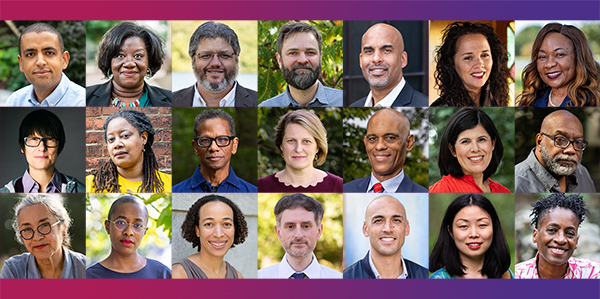Marlies Carruth, Director, MacArthur Fellows, reflects on the creative impact of broad participation and community on the 40th anniversary of the Fellows program.
As we wind down 2021, looking back crystalizes what is ahead.
As the COVID-19 pandemic continues, innovations in technology and science have enabled us to return to workplaces and schools, sporting and cultural events, convenings and celebrations. These are all steps forward toward a new normal. However, there are other fronts to our battles, as we confront dangerous science skepticism, misinformation, denial about the fragility of our democracy, and an alarming commitment to violently silencing voices of dissent and difference.
Clearly, there is still much work to do to broaden the reach of empathy and regain a sense of our shared humanity.
As 2021 comes to a close, so too does the celebration of the 40th Anniversary of the MacArthur Fellows Program. This year, we supported a multi-site, “city as gallery” exhibition, Toward Common Cause, featuring MacArthur Fellows from all four decades. The exhibition opened in July at its anchor location at the Smart Museum on the University of Chicago campus.
From the original idea of a handful of artists at a handful of locations, the project grew to 29 artists from around the country and 19 venues around Chicago, presenting a plethora of opportunities for engagement and participation across the city.
The exhibition represented a diversity of artists and artistic practices, and their responses to urgent social and environmental concerns. The work illuminated how art engages with other disciplines—economics, climate science, history, anthropology, and more—and how art offers new ways of representing our lives and relationships.
Much of the work of Toward Common Cause was developed from the ground up rather than the top-down, in close collaboration with members of the communities where the work was displayed, meeting audiences where they live and work.
The geographic reach of the exhibition was ambitious from the start. But it soon became clear that the multi-site footprint of the exhibition leveraged a wealth of existing public spaces: traditional museum venues, a library, community cultural anchors, research collectives, and social service organizations.
Installations were reimagined, designed beyond standard exhibition templates, and infused with the character of local settings. We envisioned new possibilities, sidestepped unanticipated challenges, and made new plans.
The project involved both ephemeral experiences and permanent installations. Texts and images created with young people at Centro Romero will live on after the show there has closed. Mel Chin’s Fundred Dollar Bill Project extends into its eleventh year and was embraced by a local after-school program. Kerry James Marshall’s site-specific piece at BBF Family Services is permanent and will delight regulars and visitors with its provocation and beauty. Posters from Rick Lowe’s Black Wall Street Journey circulate throughout the city.
While most of the exhibited works have come down, we are pleased to see engagement continuing with ideas and insights catalyzed by the participating artists.
These project ripples could echo long after the removal of art from the walls of the exhibition venues. In ongoing relationships between artists, between curators and artists, and between community audiences and partners, we see generative and enduring possibilities and the promise of ongoing conversations that will spawn new work and interest and more questions and dialogue.
This was always the point of the initiative.
Experimentation is nothing new to the MacArthur Fellows Program. From the beginning, the Fellows Program was unusual in its bold ambition to identify and reward creativity across all human endeavor. We now work with more nominators, evaluators, and rotating external advisors than in the earliest years of the program. New technologies and process refinements are enabling us to be more participatory—and inclusive—than ever.
We are proud of this participatory chorus. We remain committed to listening to external voices and views in the service of identifying individuals doing pathbreaking work.
The MacArthur Fellows Class of 2021 reflects such broad participation within our decades’ old selection process. The 25 Fellows of this year’s class were chosen for their exceptional creativity and their continued promise of significant impact. Once again, in this year’s class, we celebrate creative risk-takers in visual art, literature, journalism, social science, and STEM fields, such as Safiya Noble, who is highlighting the power structures built into commercial search engines and Trevor Bedford, a computational biologist improving our ability to detect novel viruses and respond to the present and future pandemics.
As usual, we announced a few firsts this year: the first married couple to each receive a separate Fellowship in the same year, reflecting individual and co-produced work; and the first formerly incarcerated Fellows to receive awards. But these choices also seem more inevitable than groundbreaking. Cristina Ibarra and Alex Rivera are veteran filmmakers with a recent genre-bending film that gives a rare glimpse into the courage of young activists revealing contemporary U.S. immigrant detention practices; Dwayne Betts and Desmond Meade have created dynamic movements to promote the rights and humanity of people with criminal records. All add much needed energy and context to prominent public debates.
On reflection, inclusion and participation can be collaborative pillars that nurture a thriving community, as evident with both the milestone celebration of the 40th anniversary through Toward Common Cause and with the robust award model of the MacArthur Fellows Program.
Such a framework may not always be the most obvious path to follow, but as with these examples, it can provide the most impactful way forward.
MacArthur Fellows grantmaking ›
MacArthur Fellows strategy ›
Other Director's Reflections ›



